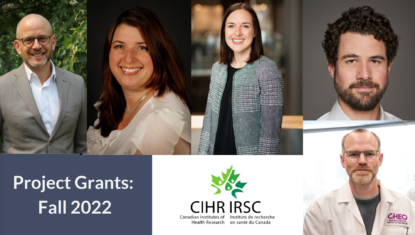08/02/2023
Ottawa, Ontario — Wednesday February 8, 2023

The CHEO Research Institute, one of the top 40 research hospitals in the country, is pleased to announce that two of its projects received Canadian Institutes of Health Research (CIHR) grants as part of the Fall 2022 Project Grant competition, and two were funded as priority announcements.
The CHEO Research Institute had a 25% success rate in this competition (CIHR average is 20.1%).
The CHEO Research Institute projects will improve understanding of Shwachman Diamond syndrome (SDS), whose patients are at a much higher risk of developing high-risk types of leukemia, and how well baseline MRI markers predict subsequent lung health and development of pre-mature babies. The priority announcements contribute to key areas of CIHR focus being breast cancer research and patient-oriented research: early-career investigator.
The successful CHEO Research Institute projects are:
Identifying novel strategies for leukemia prevention using zebrafish models of dnajc21-mutant Shwachman Diamond syndrome
Principal Investigator: Jason Berman
Co-investigators: Dror, Yigal; Ketharnathan, Sarada
Amount/term funded: $910,350 over 5 years
Early-life MRI biomarkers of longer-term respiratory morbidity in infants born extremely preterm (EMBLEM)
Principal Investigator: Sherri Katz; Giles E. Santyr
Co-investigators: Abdeen, Nishard; Altit, Gabriel; Barrowman, Nicholas J; Ben Fadel, Nadya; Gorgos, Andreea; Greer, Mary-Louise; Jain, Amish; Lands, Larry C; Lapointe, Anie; Lee, Suzie; Luu, Thuy Mai; Mohamed, Adel; Moraes, Theo; Nguyen, The Thanh Diem; Nuyt, Anne Monique; Parraga, Grace; Raghuram, Kamini; Shah, Prakeshkumar; Thebaud, Bernard; Vogel-Claussen, Jens; Voskrebenzev, Andreas
Amount/term funded: $1,202,005 over 5 years
Priority announcements:
Viralyzing transgenes to improve oncolytic immunotherapy (breast cancer research)
Principal Investigator: Tommy Alain, Tyson Graber
Co-investigators: Hoang, Dung H
Amount/term funded: $100,000 over 1 year
